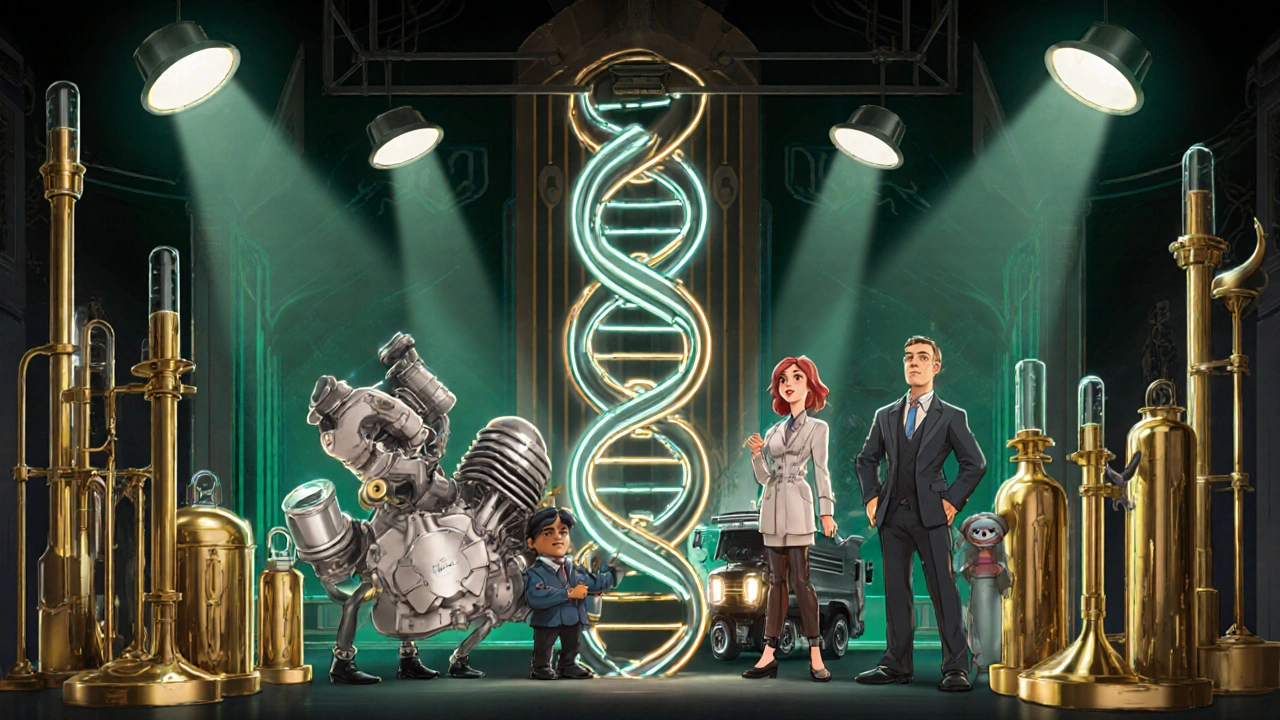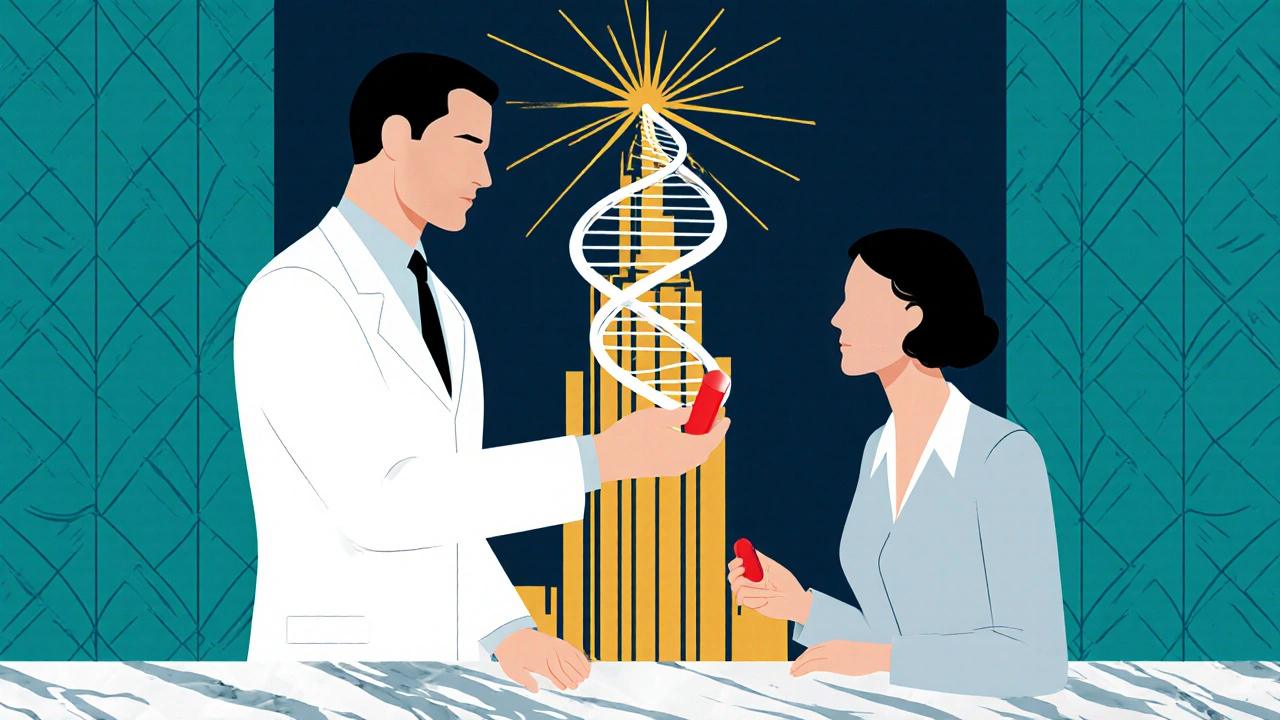Pharmacogenomic Risk Calculator
Drug Metabolism Risk Assessment
Select a medication and genetic variant to see your metabolic status and risk level.
Select a medication, gene, and genotype to see your risk level.
When a doctor prescribes a medication, the hope is that it works for everyone, but the reality is far messier. Pharmacogenomics is the science that explains why two people can react so differently to the same drug - it looks at the genetic variations that control how our bodies absorb, break down, and respond to medicines. In this guide we’ll unpack the key genes, the clinical impact, and what the future holds for tailoring therapy to each DNA blueprint.
What pharmacogenomics is and how it got started
The term merges pharmacology (the study of drugs) with genomics (the study of genes). After the Human Genome Project wrapped up in 2003, researchers finally had a complete map of the human DNA code, making it possible to link specific genetic variants to drug response. Today, the field is a cornerstone of precision medicine, with dozens of gene‑drug guidelines published by the Clinical Pharmacogenetics Implementation Consortium (CPIC) and a growing library of curated knowledge in PharmGKB.
Genetics and drug metabolism: the two‑step dance
Drug metabolism breaks down into two broad steps. Pharmacokinetics describes how the body moves the drug - from absorption to distribution, metabolism, and elimination. Pharmacodynamics covers how the drug interacts with its target once it’s inside the body. Most pharmacogenomic findings sit in the pharmacokinetic arena because genetic differences in metabolic enzymes influence the concentration of drug that reaches its site of action.
Key gene families that drive metabolism
Cytochrome P450 enzymes are the heavy lifters, handling 70‑80 % of all clinically used medicines. The most polymorphic members - CYP3A4, CYP2C9, CYP2C19, and CYP2D6 - each have dozens of variants that turn a patient into a fast, normal, or poor metabolizer.
- CYP2D6 alone processes about a quarter of common drugs, from beta‑blockers to antidepressants. Variants create phenotypes ranging from ultra‑rapid (multiple gene copies) to poor (loss‑of‑function alleles), directly shaping efficacy and toxicity.
- TPMT (thiopurine S‑methyltransferase) deficiency occurs in roughly 0.3 % of people of European ancestry and can cause life‑threatening bone‑marrow suppression if standard thiopurine doses are given.
- SLCO1B1 (also known as OATP1B1) transports statins into liver cells. Homozygous carriers of the *5 allele face a 4.5‑fold higher risk of simvastatin‑induced muscle injury.
- DPYD encodes dihydropyrimidine dehydrogenase. Deficient individuals risk severe toxicity from 5‑fluorouracil chemotherapy, a problem avoided in many cancer centers through pre‑emptive testing.
From genes to bedside: real‑world clinical impact
When clinicians act on genetic data, outcomes shift dramatically. In a 2022 JAMA meta‑analysis of 1,838 patients, pharmacogenomic‑guided antidepressant choice lifted remission rates from 39 % to 66 % and cut side‑effects by nearly 30 %.
Warfarin is another classic case. Incorporating CYP2C9 and VKORC1 genotypes shortens the time to a therapeutic INR by 2.3 days and shaves off 31 % of major bleeding events in the first month of therapy (COAG Trial, 2020).
For thiopurines used in inflammatory bowel disease, using TPMT testing prevents fatal bone‑marrow failure - a clear win for safety. Likewise, DPYD screening averts 5‑FU toxicity in roughly 0.2 % of patients, translating to hundreds of lives saved annually in oncology suites.

Testing options and how labs deliver results
Clinical labs now offer panels that interrogate 50‑100 pharmacogenes in a single run, often using Next‑generation sequencing (NGS) platforms. Turn‑around times vary: some rapid tests deliver results in 24 hours, while comprehensive reports may take up to two weeks.
| Aspect | Single‑gene test | Multi‑gene panel |
|---|---|---|
| Cost (US) | $100‑$150 | $250‑$500 |
| Turn‑around | 1‑3 days | 5‑14 days |
| Genes covered | 1‑2 (e.g., CYP2C19) | 50‑100 (including CYPs, TPMT, DPYD, SLCO1B1) |
| Clinical utility | Limited to specific drug | Broad, supports pre‑emptive testing |
Guidelines from CPIC (the Clinical Pharmacogenetics Implementation Consortium) provide dosing recommendations for 24 gene‑drug pairs, while PharmGKB (the PharmGKB knowledge base) curates over 950 drug labels with pharmacogenomic annotations.
Benefits, costs, and the equity gap
Preventable adverse drug reactions (ADRs) cost the U.S. health system billions each year. Studies estimate that up to 70 % of ADRs could be avoided with appropriate pharmacogenomic testing. By cutting emergency department visits (1.3 million annually) and hospital admissions (350 000), the economic upside outweighs the $250‑$500 per‑test price for high‑risk medications.
However, challenges remain. Reimbursement is inconsistent - only about 65 % of commercial insurers cover any PGx test, and prior‑authorizations can delay orders by two weeks or more. Moreover, most research focuses on European‑ancestry cohorts, leaving African, Asian, and Latino populations under‑represented. This disparity means many clinically actionable variants are not captured in standard panels, widening health inequities.
Implementation in health systems: success stories
The Veterans Affairs system has screened over 100 000 veterans, noting a 22 % drop in medication‑related hospitalizations. At Vanderbilt, the PREDICT program screened 100 000 patients, halving the time to effective antidepressant therapy and saving $1.9 million annually in avoided ADR costs.
Academic centers tend to adopt faster because they already have CLIA‑certified labs and research infrastructure. Community hospitals often need 24‑30 months to fully integrate pharmacogenomic decision support into electronic health records (EHRs), a process that can cost $50 000‑$200 000.

The road ahead: pre‑emptive testing and market growth
Forecasts predict the global PGx testing market will balloon to $27 billion by 2030, driven by cheaper NGS technologies and expanding insurance coverage. By 2030, many experts expect routine pre‑emptive genotyping at age 18 - a genetic passport that flags high‑risk variants before any prescription is written.
Regulators are catching up, too. The FDA cleared OneOme’s RightMed Comprehensive test in 2023, the first NGS‑based panel to receive clearance. Meanwhile, the WHO added pharmacogenomics to its Essential Diagnostics List, underscoring its global health relevance.
Yet, two hurdles dominate the horizon: closing the ancestry data gap and harmonizing reimbursement pathways. Ongoing initiatives like the NIH’s IGNITE Network and the UK’s 100,000 Genomes Project are collecting diverse genetic data to make PGx truly universal.
Quick checklist for clinicians considering PGx
- Identify high‑impact drug‑gene pairs in your practice (e.g., antidepressants, anticoagulants, thiopurines).
- Choose a testing platform - single‑gene for targeted needs, multi‑gene panel for pre‑emptive strategy.
- Integrate CPIC guidelines into your EHR’s decision‑support module.
- Educate your team - aim for 15‑20 hours of PGx training per provider.
- Verify insurance coverage early; prepare for prior‑authorization paperwork.
Frequently Asked Questions
What is the difference between pharmacokinetics and pharmacodynamics?
Pharmacokinetics describes how the body handles a drug (absorption, distribution, metabolism, elimination). Pharmacodynamics describes how the drug affects the body (target binding, therapeutic effect, side‑effects).
Which genes are most commonly tested in clinical pharmacogenomics?
The core panel usually includes CYP2D6, CYP2C19, CYP2C9, CYP3A4, TPMT, DPYD, SLCO1B1, and VKORC1. These cover many high‑risk drug‑gene interactions across psychiatry, cardiology, oncology, and pain management.
How long does a typical pharmacogenomic test take?
Rapid single‑gene assays can return results within 24‑48 hours. Comprehensive multi‑gene panels using NGS usually take 5‑14 days, depending on lab workflow.
Is pharmacogenomic testing covered by insurance?
Coverage varies. About 65 % of commercial insurers and 87 % of Medicare Advantage plans cover at least one PGx test, but prior‑authorization and variable reimbursement rates remain common obstacles.
Can direct‑to‑consumer tests replace clinical pharmacogenomics?
DIY kits like 23andMe provide limited PGx reports (usually 5‑10 drugs) and are not a substitute for CLIA‑certified clinical testing, which examines a broader set of genes with validated dosing guidelines.
Understanding how our DNA directs drug metabolism is no longer a futuristic concept - it’s already shaping prescriptions today. By embracing pharmacogenomics, clinicians can cut adverse events, improve therapeutic success, and move closer to truly personalized care.

Wow, another buzzword‑filled article that pretends to be revolutionary but just rehashes what we’ve known for years.
🤔 In the grand theater of medicine, pharmacogenomics is the spotlight that finally reveals the hidden actors of our DNA, yet many still cling to the shadows of old‑school prescribing. 🌟
Hey folks, let’s unpack why this isn’t just geek‑speak but a real game‑changer for patients. Think of the genome as a gigantic recipe book; each gene variant is a different spice that can make a drug taste sweet or turn it bitter. When we match meds to those spices, we’re essentially customizing the flavor profile for each individual’s health palate. The data on CYP2D6 and DPYD already show dramatic drops in toxicity when clinicians listen to the genetic cues. So, the take‑away is simple: the more we integrate these genetic hints, the fewer nasty side‑effects we’ll see across the board.
Interesting read…; the field is moving fast!!!; I love how the article breaks down the CYP families-especially the ultra‑rapid metabolizers-; definitely something to watch for in the clinic.
Wow, this piece really hits the nail on the head-pharmacogenomics is like the hidden orchestra behind every prescription! I mean, imagine prescribing warfarin without checking CYP2C9… you’d be dancing on a razor’s edge. The stats about the veterans program blew my mind, even if I typoed a few words here- sorry! Anyway, the equity gap is a real tragedy; we can’t let only European‑ancestry data shape care for everyone. Let’s push for broader panels and stop leaving half the world in the dark.
It’s worth noting that the cost‑benefit analysis often leans heavily in favor of testing when you factor in avoided hospitalizations. For instance, a single CYP2C19 test can prevent a costly bleed in a patient on clopidogrel. Moreover, many labs now offer 48‑hour turnaround for high‑risk panels, making it feasible even in urgent settings. The CPIC guidelines are quite clear on dose adjustments for poor metabolizers, and most EHR systems can flag these automatically. So, integrating PGx isn’t just futuristic-it’s already a practical tool for the modern clinic.
Sure, if you love spending extra dollars for marginal gains, go ahead.
Let’s keep the conversation friendly-everyone’s learning here, and sharing resources helps us all move forward together.
I have to say, the hype around pharmacogenomics sometimes feels like a tech‑bro hype train that’s forgotten the basics of good clinical judgment. First, not every drug needs a genetic test; the majority of prescriptions work fine without sequencing. Second, the panel costs, while dropping, are still a barrier for many small practices that run on razor‑thin margins. Third, we keep hearing about “pre‑emptive testing at age 18,” but the evidence for blanket testing is still patchy at best. Fourth, the guidelines are riddled with exceptions-if you follow them religiously, you might end up with decision‑fatigue. Fifth, let’s talk about the data bias; most of the allele frequencies come from European cohorts, so you’re left guessing for African or Asian patients. Sixth, the labs sometimes mis‑label variants, leading to unnecessary dose changes. Seventh, clinicians often lack proper training, so the results sit in the EHR gathering digital dust. Eighth, there’s a regulatory lag-FDA clearances happen after the market is already saturated. Ninth, insurance coverage is a wild west; a prior‑authorization can take weeks, delaying care. Tenth, the “real‑world” studies show modest reductions in adverse events, not the dramatic miracles some marketers claim. Eleventh, you can’t ignore the fact that many drugs have wide therapeutic windows, making PGx less critical. Twelfth, the patient’s adherence and lifestyle factors often outweigh genetic predispositions. Thirteenth, we’re seeing a rise in direct‑to‑consumer tests that give incomplete reports, confusing patients more than helping them. Fourteenth, the “genetic passport” idea sounds great, but who will maintain and update it over a lifetime? Fifteenth, I’m not against the science-just wary of the commercial push that might outpace solid evidence. Finally, let’s keep our feet on the ground and use pharmacogenomics where it truly adds value, not as a blanket solution for every prescription.